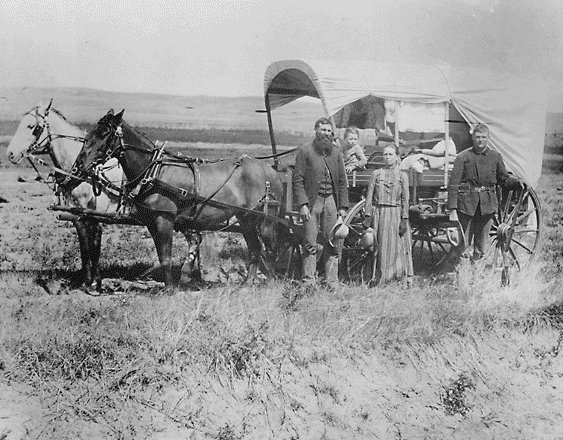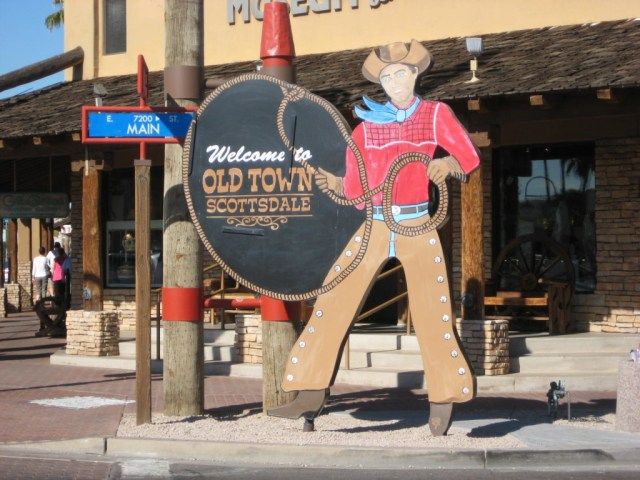A writer walks through a suburb of a desert city. He finds that art, souvenirs, tradition , memory, and dam-building and citrus trees have something to do with each other. This is the third of five essays.
Everything about the history of Scottsdale fits in its motto, which it chose in 1950: “The west’s most western town.”
The Winfield brothers came to the area around 1890. They and others slowly began the markets that Scottsdale and the larger Phoenix area would be known for: copper, cattle, cotton, and citrus. It’s population increased from 2,000 people in 1951 to 68,000 in 1968 to 202,000 in 2000. As it grew, it needed more space. Space was made. The town grew outward. It is today a lucrative, well-thought-out, 65 year-old city. Many factors, those changing or unforeseen motivations, persons coming to and fro, and often murder, make a town. The mailman was the first to shoot someone.
Old Downtown is striking for the western-ness of it. There are posts for horses, tin roofs and tumbleweeds. The streets are made of cobblestone with distant vanishing points. In cowboy movies, instead of making the entire buildings, they often just put up the storefronts. There was nothing to walk into and the front of a general store or the sheriff’s office was simply the background for the camera following the new character into town. Had the camera floated up, all there’d be to see is buttressed walls. The stores here looked like that western. The city council, as tourism became a prospect, intentionally gave this facade to the town. It has an annual tourism population of 6 million and an economy of a few billion (much of it from art and souvenir sales). The city is clean, dustless.
Scottsdale wants to incarnate “westernness.” It calls itself the superlative of all places western, “the west’s most western town,” a self-proclaimed archetype of the pre-Civil War to late 1800’s expansion, even though the land was bought in 1900, not recognized as a city until 1950, and intentionally makes itself “appear” western. It has enjoyed financial success from this enterprise: superlatives are curiosities.
People from the past look historical, either from how they smile or look into the camera lens, even their physical features. In the 1800s, towns were often built near railroads. People left their homes, a time of Manifest Destiny, Civil War, gold rushes, cattle wrangling. Pilgrims, cowboys, and free-landers needed supplies. Railroads were the veins of westward-reaching arms. Photography was just beginning then, black and white and out of focus. Pictures from that time have an almost magical chemical-ness feel to them. The clothes look like costumes. No one dresses that way except at custom parties and renaissance festivals. This history seems itchy, untouchable.

Enough time makes a thing seem to have happened elsewhere. Russian philosopher and literary critic, Mikhail Bakhtain writing about the epic genre of literature states: “as the specific genre known to us today, [epic literature] has been from the beginning a poem about the past, and the authorial position immanent in the epic and constitutive for it … is the environment of a man speaking about a past that is to him inaccessible, the reverent point of view of a descent … epic discourse is infinitely far removed from discourse of a contemporary.”
The epic does not look for perfection in the present or the future. Instead, it claims there was a golden age, a time that has gained that otherworldly texture to it. Through its telling, the past becomes exotic, extraterrestrial. The past is an ancestor so genealogically ancient that he looks nothing like his children. Back then, men fought with true virtue, the nation was at peace, the knights defeated the dragons, all lived happily ever after. This time exists safely and securely on the other side of some unbridgeable canyon: fantasy, myth, legend, history, recovered from fragments of parchment and the walls of caves.
Alternatively, perfection might lie in the future. Imagine ideas quarreling then combining with each other, over and over, until they mix their differences into an equalized ideal. Our belief in progress is to hope that all disagreements and difficulties will be solved in time. It’s all a math problem that’s taking a frustratingly long time to figure.
In either case, the contemporary is not the site of perfection but of departure. There’s the land we’re trying to return to, finally arrive at, or recapture in memoria, that, apart from brief visitations, we never really get to. The goal lies always across the way, and we like rocks skipping across a river are not yet at rest.
All the speculation as to where perfection lies, Scottsdale forgoes. Instead, it simply gives us souvenirs and tourism. Town’s don’t give themselves mottos to attract tourism or fashion souvenirs just because they like visitors and paraphernalia. In the case of souvenirs and tourism, both walking around a place and taking back a piece from that place encapsulates a memory that, by any other means, remains untouchable. What else could be meant by its assertion – “the west’s most western town” – than that the Ideal exists in the contemporary, today? Scottsdale tells us that the past it touchable. We have the longed-for object at last.

And what if, as Scottsdale claims, the ideal is realizable; what if it’s unattainability, it’s absolute alienation, is false? Tourism and souvenirs incorporate what remembering is a vague representation of.
In so many ways, Scottsdale is not connected to the spirit of the West, its history, its troubles, its films. Scottsdale became a city after Westward Ho with John Wayne, and a slew of other movies made in the 1930s. Scottsdale claims to be the most western town, even when it became a town after the West existed. Who expected the spirit to appear when the West had passed? But it claims to be it nonetheless, when every other place sighs and tries to remember.
Scottdale’s motto refuses to privilege any notion of perfection . It steals perfection from the past, presumes it from the future, captures it despite its alterity. Wherever the ideal is made to dangle, Scottsdale plucks it off. It’s odd, as if the archetype of ancient Rome was born yesterday, or the best play of Shakespearean English written in 1990.
There’s something good, even possible, about this. That whatever a period hundreds or thousands of years ago was trying to be should appear in a different period asks if we would think of time differently. Memory is not an uncross-able distance, but the completion of history and the perfection of the future and the ideal – all at once made present. Perfection does not lie in the epic past, but the ordinary present.
There’s a funny paradox when memory becomes present to us, like recalling someone who is standing next to you, or being forgiven before you’ve repented, or knowing a future event like it happened yesterday. A tension releases before it had time to wind up, music plays from instruments still locked in their cases.




